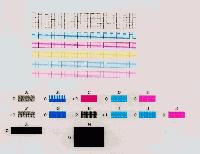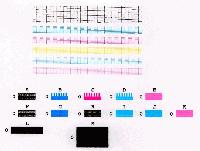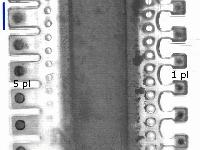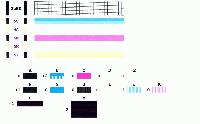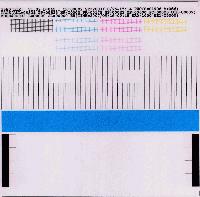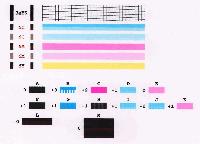Trigger 37
Printer Guru
- Joined
- Dec 23, 2006
- Messages
- 607
- Reaction score
- 4
- Points
- 136
This post is directed to the inkjet masters of this website. I would like to propose that this thread be used to collect and identify successful ways to confirm or not confirm printhead failure. This thread is not for those people who want to post a question about their printhead, but only for the people that feel they have good knowledge on how to isolate a good printhead from a bad one. Once we begin to get some solid answer, this will then help the 100's of people who are having the problem and don't know whether to buy a new printhead or just keep trying to clean their old one. This thread can also be used to identify how and why printheads go bad.
Right now I have about 7 printhead that are in question. One of them finally gave me the answer the other day. I had been trying for days to use every cleaning trick I could to clear up the problem and finally it turned to smoke in front of me. I was testing the Qy6-042 in my MP730 and it quit in the middle of a nozzle test with an error message, "WAIT -COOLING". It would not even let me get the printhead out of the printer. All of these printheads have temperature sensors in them and that is one of the items listed in the Service Test print. After letting it cool for 10-15 minutes, and pulling the power out of the printer and then putting it back, I finally got the printer to move the printhead to the center so I could get it out. It was still very warm to the touch. Under close inspection after some detailed cleaning I saw the burnt spots on outside row of nozzles. Several of them were just melted together. If this was not bad enough, I put another know good printhead back in the same printer, and it would not print at all. So it appears that the short that burnt out the first printhead has also burnt out the printhead driver.
The printer gives not error conditions and continues to try and function, but of course it can't print anything. At first I thought I good be damaging the other new printhead, but as I have several MP730's, I move the good head to that unit and it still works fine. Now I need a way to test the first printer to see if I've blown the logic card, since that is where the print driver is located. I know the odds of fixing this are about 1 in 1000. It is probably a very small 3pin IC high power driver, and of course it will be surface mounted which requires very expensive tools to even attempt to replace. I have the tools to check all the power supplies, but because every thing else in the printer works fine, I suspect the power is OK. If I get really lucky the problem could be in one of the cables or connectors to or on the Carriage Asm. Those cost a lot less than a logic card. This is all work to be done. In one way I'm lucky to have so much equipment that I can cross check a printhead from two different printers. The bad news about this is that if I put a bad printhead into a good printer to test the printhead, it is possible to kill a good printer. So this is the reason I would like to have this forum and this thread accumulate good information on how to isolate good/bad printheads. For example, I could take a known good printhead and do some electrical ohm meter measurements on all the contacts to know points. I have the pin assignments for each contact but not the schematic. I'm not sure this is a good idea since I know how sensitive the input pins are of all semiconductors. IF someone has done this kind of "Static" testing, it would be great to know about.
Another printhead problem that shows up many times in this forum is the "Picket fence" printing of the nozzle check pattern. I don't have time today to load an image of what I mean but the characters below will give you some idea.
||| ||| ||| |||
||| ||| ||| |||
Many people have posted this problem and several people have suggested to them that this is obviously an electrical problem because it is so symmetrical. This COULD be the answer, but not all the time. I was testing another i850 that came to me as defective and I had to replace several parts including the drive belt and the Timing Code strip. Once those were fixed it printed the nozzle test the first time but it was bad since the printer had not been run for over 3 months. The first print of the cyan showed the same "Picket Fence" pattern that would imply some other electrical problem. However, the nozzles that print every other column are from a different bank of nozzles. It is just as easy for an entire bank of nozzles to be clogged as it is for them to go bad electrically. I did 2 deep cleaning cycles and cleared up the Picket Fence and now the nozzle check is perfect. So the answer is, it could have been a contact or it could have been a clogged nozzle bank. In my case it was the latter.
Here is another quick example of problems that people have that cause many to jump in the wrong direction. In the same printer, after I had printed several excellent nozzle check patterns, I put the printer into Service mode and printed the Service Test pattern. This always tells me more about the "TOTAL PRINTER" than just the nozzle check. The reason for this is the nozzle check uses only the very smallest about of ink flow. A real test is to see if it can sustain printing solid color bars of BKCMY. So I printed the color test pattern and in less than 2 inches the black ink faded to nothing, while all the other colors worked ok. This shocked me as I had just refilled the black in cart and tested it with a good nozzle check. I replaced it with another black ink cart (I have about 6 sets laying all over the place) and did another deep cleaning of black and re-ran the test. This time everything was perfect. So what was the problem,... not the printhead. Even though I had just put in a refilled ink cart, that cart was probably clogged internally. I've seen many suggestions that older carts get air trapped inside and the ink can't flow sufficiently.
I believe the inkjet masters of this forum have the knowledge and experience to bring together many answers to these printhead problems and these answers will help 100's of people that use this forum. I'm looking forward to your suggestions.
Right now I have about 7 printhead that are in question. One of them finally gave me the answer the other day. I had been trying for days to use every cleaning trick I could to clear up the problem and finally it turned to smoke in front of me. I was testing the Qy6-042 in my MP730 and it quit in the middle of a nozzle test with an error message, "WAIT -COOLING". It would not even let me get the printhead out of the printer. All of these printheads have temperature sensors in them and that is one of the items listed in the Service Test print. After letting it cool for 10-15 minutes, and pulling the power out of the printer and then putting it back, I finally got the printer to move the printhead to the center so I could get it out. It was still very warm to the touch. Under close inspection after some detailed cleaning I saw the burnt spots on outside row of nozzles. Several of them were just melted together. If this was not bad enough, I put another know good printhead back in the same printer, and it would not print at all. So it appears that the short that burnt out the first printhead has also burnt out the printhead driver.
The printer gives not error conditions and continues to try and function, but of course it can't print anything. At first I thought I good be damaging the other new printhead, but as I have several MP730's, I move the good head to that unit and it still works fine. Now I need a way to test the first printer to see if I've blown the logic card, since that is where the print driver is located. I know the odds of fixing this are about 1 in 1000. It is probably a very small 3pin IC high power driver, and of course it will be surface mounted which requires very expensive tools to even attempt to replace. I have the tools to check all the power supplies, but because every thing else in the printer works fine, I suspect the power is OK. If I get really lucky the problem could be in one of the cables or connectors to or on the Carriage Asm. Those cost a lot less than a logic card. This is all work to be done. In one way I'm lucky to have so much equipment that I can cross check a printhead from two different printers. The bad news about this is that if I put a bad printhead into a good printer to test the printhead, it is possible to kill a good printer. So this is the reason I would like to have this forum and this thread accumulate good information on how to isolate good/bad printheads. For example, I could take a known good printhead and do some electrical ohm meter measurements on all the contacts to know points. I have the pin assignments for each contact but not the schematic. I'm not sure this is a good idea since I know how sensitive the input pins are of all semiconductors. IF someone has done this kind of "Static" testing, it would be great to know about.
Another printhead problem that shows up many times in this forum is the "Picket fence" printing of the nozzle check pattern. I don't have time today to load an image of what I mean but the characters below will give you some idea.
||| ||| ||| |||
||| ||| ||| |||
Many people have posted this problem and several people have suggested to them that this is obviously an electrical problem because it is so symmetrical. This COULD be the answer, but not all the time. I was testing another i850 that came to me as defective and I had to replace several parts including the drive belt and the Timing Code strip. Once those were fixed it printed the nozzle test the first time but it was bad since the printer had not been run for over 3 months. The first print of the cyan showed the same "Picket Fence" pattern that would imply some other electrical problem. However, the nozzles that print every other column are from a different bank of nozzles. It is just as easy for an entire bank of nozzles to be clogged as it is for them to go bad electrically. I did 2 deep cleaning cycles and cleared up the Picket Fence and now the nozzle check is perfect. So the answer is, it could have been a contact or it could have been a clogged nozzle bank. In my case it was the latter.
Here is another quick example of problems that people have that cause many to jump in the wrong direction. In the same printer, after I had printed several excellent nozzle check patterns, I put the printer into Service mode and printed the Service Test pattern. This always tells me more about the "TOTAL PRINTER" than just the nozzle check. The reason for this is the nozzle check uses only the very smallest about of ink flow. A real test is to see if it can sustain printing solid color bars of BKCMY. So I printed the color test pattern and in less than 2 inches the black ink faded to nothing, while all the other colors worked ok. This shocked me as I had just refilled the black in cart and tested it with a good nozzle check. I replaced it with another black ink cart (I have about 6 sets laying all over the place) and did another deep cleaning of black and re-ran the test. This time everything was perfect. So what was the problem,... not the printhead. Even though I had just put in a refilled ink cart, that cart was probably clogged internally. I've seen many suggestions that older carts get air trapped inside and the ink can't flow sufficiently.
I believe the inkjet masters of this forum have the knowledge and experience to bring together many answers to these printhead problems and these answers will help 100's of people that use this forum. I'm looking forward to your suggestions.

